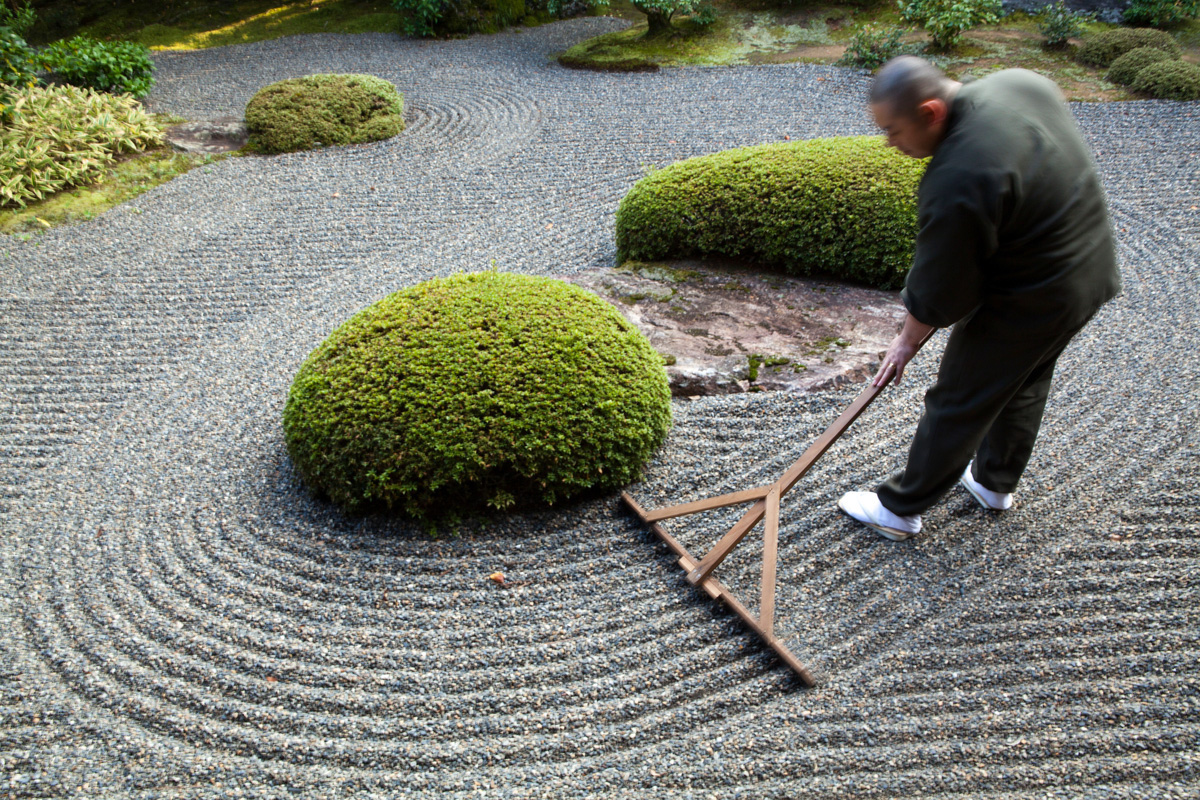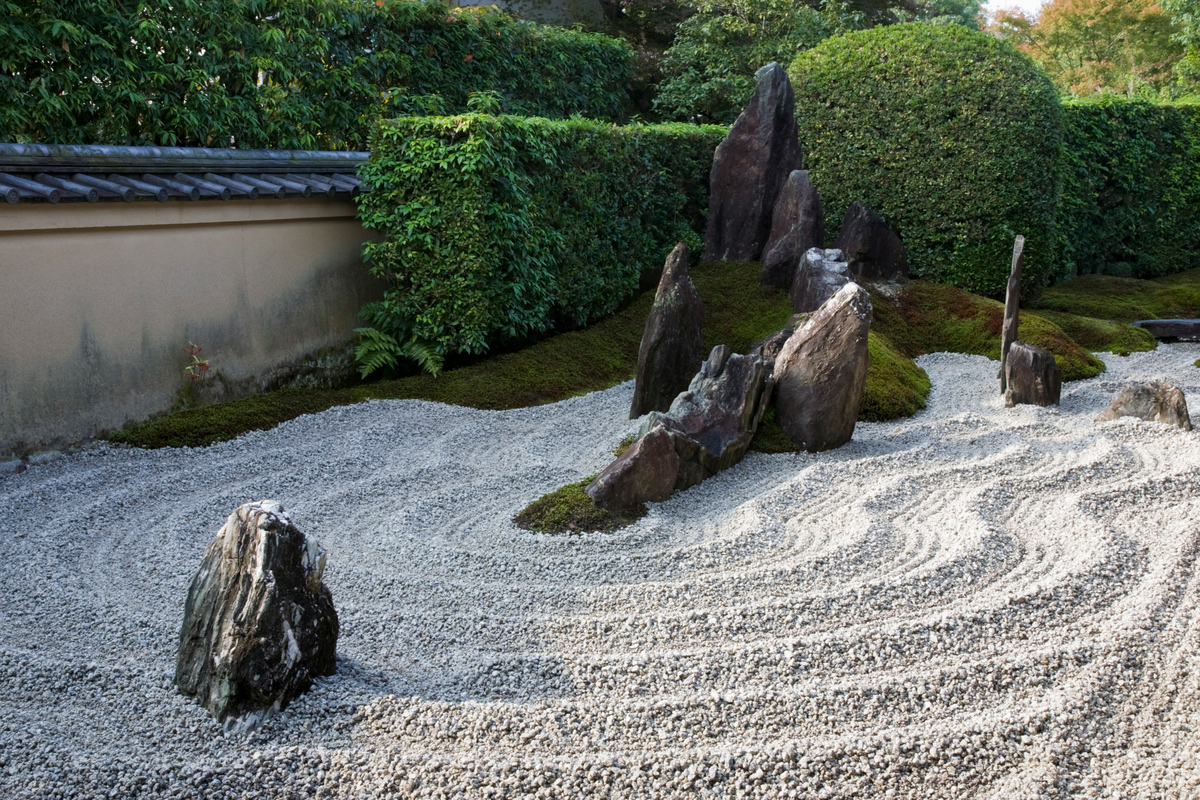Japanese Garden Images

Byodo-in is a Buddhist temple in the city of Uji in Kyoto prefecture, a National Treasure and a World Heritage Site. Its outline is featured on the ¥10 coin. Built in 998 AD during the Heian period, Byodo-in was originally a private residence like many Japanese temples. It was converted into a temple by the Fujiwara clan in 1052. The Phoenix Hall, the great statue of Amida inside it, and several other items at Byodoin are Japanese National Treasures. UNESCO listed the building as a World Heritage Site in 1994.

Kogetsudai, - Ginkakuji is a Zen temple at the foot of Kyoto's Higashiyama or "eastern mountain". The temple was formally known as Tozan Jishoji and built in 1482 as a retirement villa for shogun Ashikaga Yoshimasa. A few years later, the Silver Pavilion was constructed, modeled after Kinkakuji's Golden Pavilion. Plans to cover the pavilion in silver were never realized yet the name Silver Pavilion stuck. The villa was converted into a Zen temple after Yoshimasa's death and is well known for its zen garden.

Japanese Gardener - Rev Takafumi Kawakami is the vice-abbot at Shunkoin Temple and teaches classes about Zen culture and meditation and serves as a bridge between Eastern and Western cultures. Here Rev Takafumi is raking the temple's Zen Garden. The Garden of Bolders, or Sazareishi-no-niwa, is the main garden of Shunkoin. The theme of the garden is the Great Shrine of Ise in Mie Prefecture. The Great Shrine of Ise is the head shrine of all Shinto shrines in Japan. This garden houses a shrine to Toyouke-no-omikami, a goddess of agriculture.

Kotoji-toro, a stone lantern with two legs is said to resemble the bridge on a koto. This lantern is the symbol of Kenrokuen and Kanazawa. Kenrokuen or the "Six Attributes Garden" (spaciousness, seclusion, artifice, antiquity, watercourses and panoramas). Along with Kairakuen and Korakuen, Kenrokuen is one of the Three Great Gardens of Japan.

Stepping Stones at Kiyosumi Teien Garden - the site of the residence of the Edo Period business magnate, Kinokuniya Bunzaemon. Later it became the residence of the Lord of Sekiyado castle, the period when the basic form of the garden came into existence. In 1878 Iwasaki Yataro chose this property as a garden for the entertainment of important guests. In later years, famous rocks from all over Japan were brought in to embellish the garden. The garden was completed in the Meiji Period and developed into a famous strolling garden centered around a large pond.

Komyoji Garden at Komyoji Temple is a rare dry garden, sometimes called a Zen garden, as this temple is not of the Zen sect of Buddhism. It is a popular temple with locals in the Kamakura area for its abundant cherry blossoms in spring, frequent flea markets, and free parking near the beach.

Zuiho-in Zen Garden's most intriguing feature is its main rock garden called "Dozuka-tei", which is raked into appealing patterns to suggest water ripples lapping against rock formations representing the Hohrai Mountains. It was designed by Mirei Shigemori and is considered one of his most interesting modern Japanese gardens.

Ryoanji - The Temple of the Dragon at Peace - is a Zen temple located in Kyoto well known for its famous zen garden. The garden is thought to have been built in the late 15th century and consists of raked gravel and fifteen moss covered boulders, which are placed so that, when looking at the garden from any angle only fourteen of the boulders are visible at one time. It is said that only through attaining enlightenment could you be able to view the fifteenth boulder.

Ryogen-tei Garden at Ryogen-in which has a collection of Zen gardens. The most interesting would be Ryogin-tei, a Karesansui or dry garden designed and laid out in the early 16th century.

The Moss Garden at Saihoji Temple is one of the few temples in Kyoto where visitors must request an invitation in advance before their visit. Visitors are required to participate in chanting and writing wishes before visiting the famous gardens. In this way the monks are able to maintain the temple and garden and prevent mass tourism from destroying the tranquility of the moss garden.

Shisendo is both a hermitage and garden in eastern Kyoto established by Jozen Ishikawa, a scholar and landscape architect. After he retired from samurai service he devoted the rest of his life to learning Chinese classics. When he was 59 he built his masterpiece as a retirement villa which has come to be known as Shisendo.

Tenryuji Sogenchi Pond Garden - Tenryuji Garden has been ranked first among Kyoto's "Five Great Zen Temples". Tenryuji was established in 1339, and like many other temples burnt down several times over its history. Muso Soseki, the temple's founding abbot and famous garden designer, created Tenryuji's landscape garden which, unlike the temple buildings, survived the many fires and is considered one of the oldest of its kind, that is "borrowed landscape" garden, taking in the background scenery of the hills of Arashiyama as part of the garden's composition. Sogenchi pond and Ishigumi rock clusters in the garden are this pond garden's essential ingredients.

Northern Garden, Tofukuji Temple. Square cutted stones and moss are distributed in a chequered pattern. Though modern in its style and composition, this is one of the most unique gardens in Japan.

Taizoin modern pond garden Yoko-en was designed by Kinsaku Nakane in the 1960s. It is a kind of strolling garden with a stream that cascades along the main axis, flanked by azeleas. The stream flows around rocks, gradually widening until it empties into a pool in front of the viewer at the bottom. Japanese green tea is served at the viewing area. At the top of Yoko-en is the heaven and hell garden, made up of raked sand: white for heaven and dark for hell.


